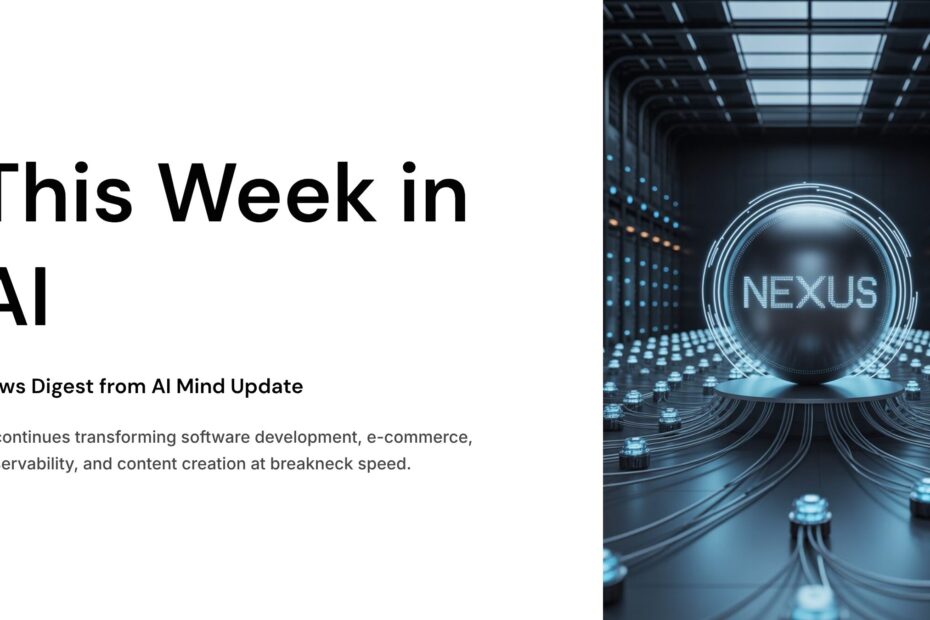This Week’s News Digest from AI Mind Update
The artificial intelligence landscape continues to evolve at breakneck speed, transforming everything from software development to e-commerce, observability, and content creation. This week’s digest from AI Mind Update brings you the most significant developments shaping the tech industry, from Microsoft’s groundbreaking Agent Framework to the revolutionary integration of instant checkout in ChatGPT. Whether you’re a seasoned developer, a curious entrepreneur, or someone simply fascinated by the intersection of technology and daily life, these ten stories offer crucial insights into where AI is heading and how it’s reshaping our digital world.
🎥 Watch the Latest Episode of AI Mind Update
Dive into this week’s AI Mind Update Weekly Digest, where John and Lila chat through ten of the hottest AI topics shaping the tech world. From on-device intelligence to no-code automation, they mix insights with humor for an easy, engaging listen.
Check out the video below and stay tuned for more weekly updates!
🎧 Listen to the Latest AI Mind Update Podcast
Enjoy a lively, dialogue-style episode featuring John and Lila, as they explore this week’s top ten AI stories from the AI Mind Update Weekly Digest.
With humor, curiosity, and easy-to-follow insights, the two hosts make complex topics feel fresh and engaging.
Tune in below and enjoy the conversation!
1. The Great JavaScript Debate: Will AI Replace Human Developers?
The question on every developer’s mind in 2025 continues to be whether artificial intelligence will eventually replace human programmers, particularly in the JavaScript ecosystem. According to recent analysis from InfoWorld and multiple developer surveys, the answer is more nuanced than a simple yes or no.
JavaScript remains the backbone of modern web development, powering everything from interactive websites to complex server-side applications through Node.js. The language continues to evolve with new features like the Temporal API and ES2025 updates, making it more robust and developer-friendly. However, AI tools are becoming increasingly sophisticated at generating code snippets and automating routine tasks.
The reality check reveals that while AI can generate impressive code snippets and handle repetitive tasks, human developers still play irreplaceable roles in system architecture, creative problem-solving, and contextual decision-making. AI serves as a powerful augmentation tool rather than a replacement, helping developers work more efficiently while they focus on higher-level design and innovation.
Current trends show that experienced developers are actually embracing AI tools more readily than newcomers, using them to enhance productivity rather than feeling threatened. The key insight is that successful developers in 2025 are those who learn to work alongside AI, leveraging its capabilities while applying human judgment and creativity to complex problems.
The implications for the industry are significant: development workflows are becoming more efficient, but the demand for skilled developers who can guide and optimize AI-generated code is actually increasing. Companies are finding that the most successful projects combine AI efficiency with human oversight and strategic thinking.Source: https://aimindupdate.com/2025/10/05/is-ai-replacing-javascript-developers-the-reality-check/
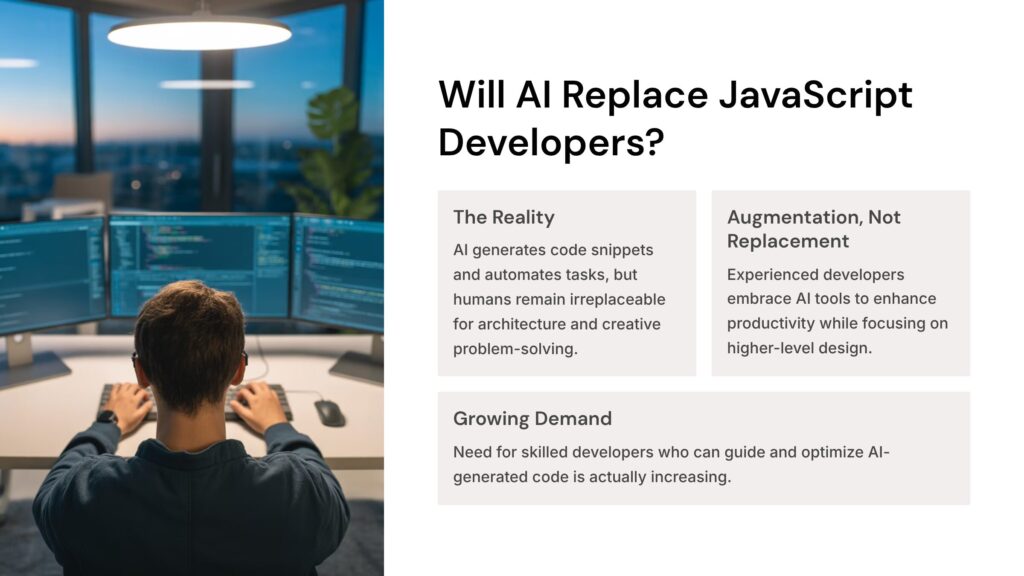
2. Internal Developer Platforms: Revolutionizing Software Development Workflows
Internal Developer Platforms (IDPs) are emerging as one of the most significant trends in software development, representing a paradigm shift toward self-service infrastructure and streamlined development workflows. These platforms are essentially customized toolkits that organizations build to help their developers work more efficiently by abstracting away complex infrastructure management.
Unlike generic Platform-as-a-Service offerings, IDPs are tailored to fit a company’s specific technology stack, culture, and operational requirements. They typically include self-service portals where developers can provision environments, deploy applications, and monitor performance without waiting for operations teams to intervene.
The key features driving IDP adoption include automated workflows for building and deploying software, ephemeral environments for testing, integration with CI/CD pipelines, and standardized templates that promote best practices while maintaining developer autonomy. These capabilities are proving crucial for organizations trying to balance standardization with innovation flexibility.
Recent developments show a surge in IDP interest over the past 18 months, driven by the need for more efficient DevOps practices. Google’s Cloud IDP and other major platforms are shifting toward app-centric services, potentially replacing some in-house platform engineering efforts with cloud-native solutions.
The implications extend far beyond just operational efficiency. IDPs are enabling faster time-to-market for applications, improving developer satisfaction by reducing friction, and allowing organizations to scale their development capabilities without proportionally increasing infrastructure complexity. For smaller teams, open-source IDP frameworks are making these benefits accessible even without massive enterprise budgets.Source: https://aimindupdate.com/2025/10/05/internal-developer-platforms-the-future-of-software-development-explained/
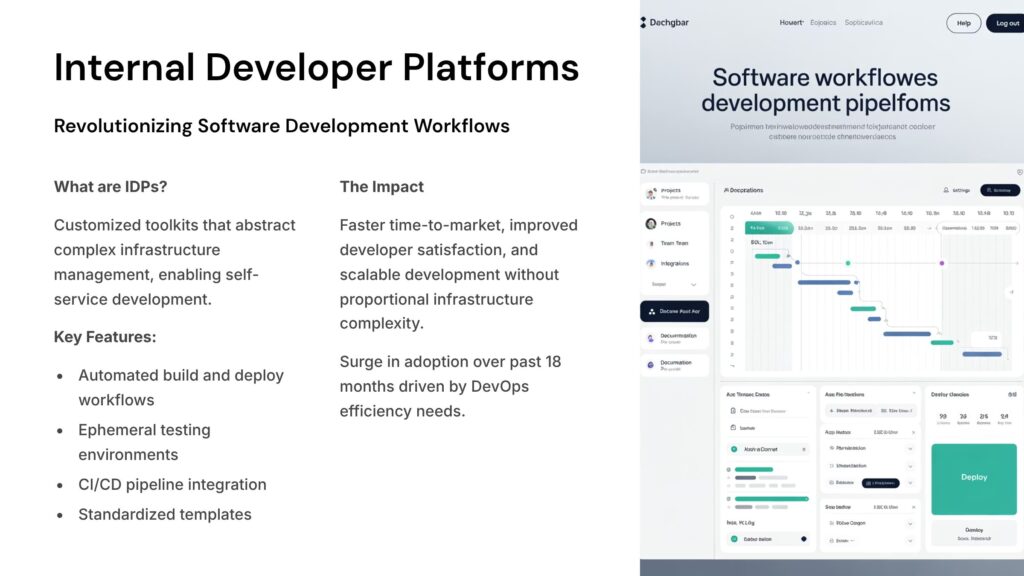
3. Microsoft’s Agent Framework: Democratizing AI Application Development
Microsoft has made a bold move in the artificial intelligence space with the launch of its Agent Framework, an open-source software development kit designed to simplify the creation, orchestration, and management of AI agents. This framework represents a significant step toward making sophisticated AI applications accessible to developers across all skill levels.
The Agent Framework consolidates Microsoft’s existing AI tools, including Semantic Kernel and AutoGen, into a unified platform that supports both .NET and Python development environments. This consolidation addresses one of the biggest challenges in AI development: the complexity of managing multiple tools and ensuring they work together seamlessly.
What sets this framework apart is its focus on production-ready AI agents that can reason about goals, call external APIs, collaborate with other agents, and handle complex workflows autonomously. The platform includes built-in hosting capabilities, observability features for monitoring agent behavior, and governance tools to ensure ethical and secure AI operations.
The framework’s unified orchestration capabilities enable developers to create multi-agent systems where different AI agents can specialize in specific tasks and work together to accomplish complex objectives. For example, one agent might handle customer inquiries, another could access databases, and a third might escalate issues to human operators—all coordinated through the framework’s orchestration layer.
The implications for enterprise AI adoption are substantial. By lowering the technical barriers to AI agent development and providing enterprise-grade governance features, Microsoft is positioning itself to capture a significant portion of the growing market for business AI applications. The open-source nature of the framework also encourages community contribution and innovation, potentially accelerating the overall development of the AI agent ecosystem.Source: https://aimindupdate.com/2025/10/05/microsofts-agent-framework-build-powerful-ai-apps-with-ease/
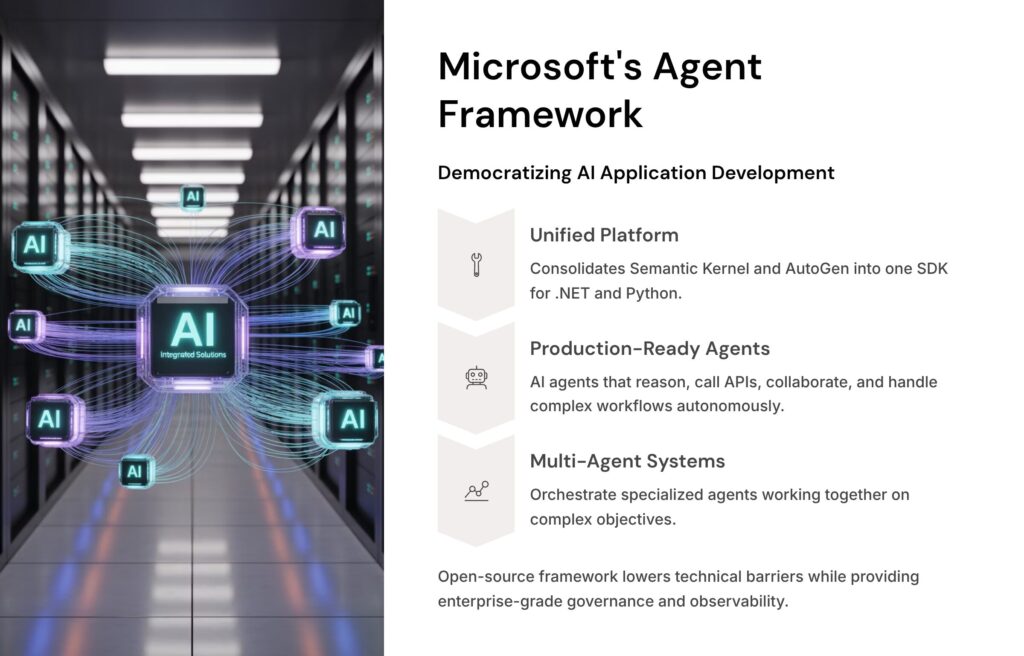
4. Chainguard’s Security Revolution: Malware-Resistant JavaScript Libraries
The software supply chain security landscape received a significant boost this week with Chainguard’s introduction of malware-resistant JavaScript libraries. This development addresses one of the most pressing security challenges facing modern software development: the risk of malicious code infiltrating popular open-source packages.
Chainguard’s approach involves rebuilding thousands of common JavaScript dependencies entirely from their original source code using SLSA Level 2 infrastructure. This process ensures that the libraries are verifiable, minimal, and free from potential security vulnerabilities that could have been introduced during the original build or distribution process.
The timing of this initiative is particularly significant given recent high-profile supply chain attacks targeting JavaScript packages. Incidents involving popular packages have demonstrated how quickly malicious code can propagate through the ecosystem when it infiltrates widely-used dependencies, potentially affecting millions of applications worldwide.
The technical implementation leverages Supply Chain Levels for Software Artifacts (SLSA) Level 2 compliance, which provides verifiable build integrity and ensures that every library can be traced back to its original source code. This transparency is crucial for enterprise environments where security and compliance are paramount concerns.
The broader implications extend beyond just JavaScript security. Chainguard’s approach could establish a new standard for secure open-source package distribution, potentially influencing how other language ecosystems handle supply chain security. The success of this initiative in JavaScript could pave the way for similar security-focused rebuilds of packages in Python, Java, and other popular development languages.Source: https://aimindupdate.com/2025/10/05/chainguard-fortifies-javascript-introducing-malware-resistant-libraries/
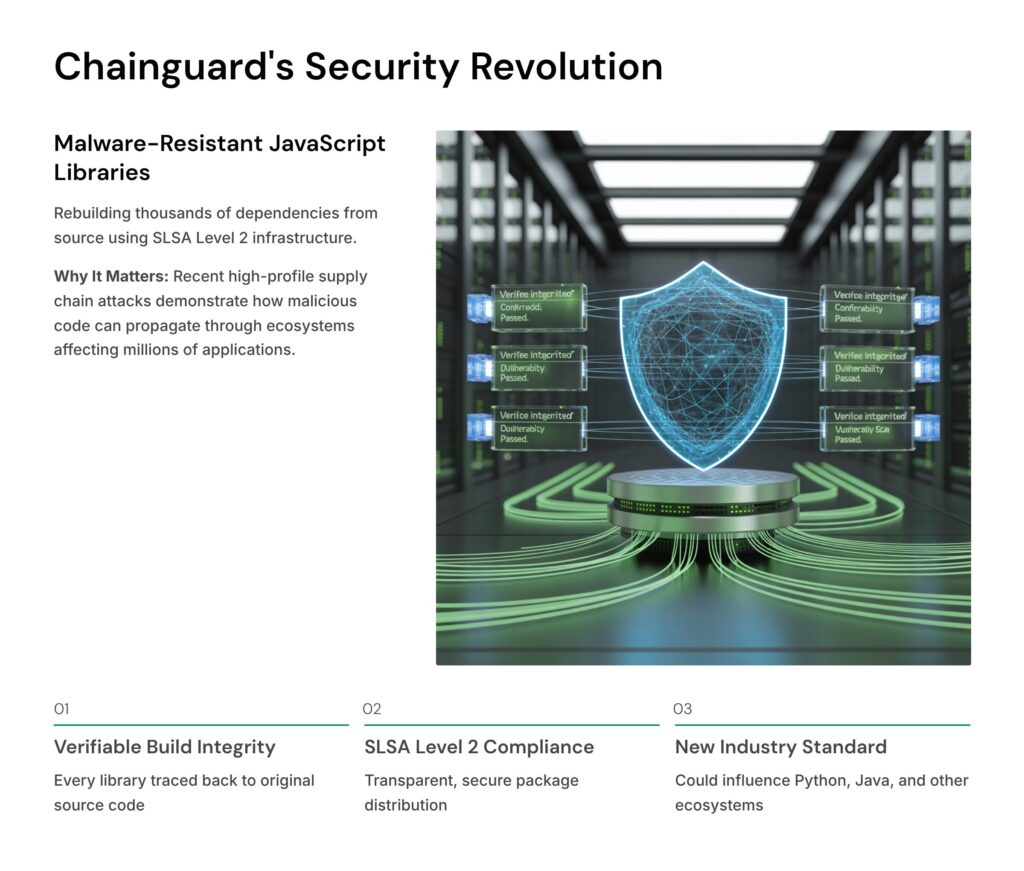
5. The Future of E-commerce: Instant Checkout in ChatGPT
OpenAI has fundamentally transformed the e-commerce landscape with the introduction of Instant Checkout functionality directly within ChatGPT. This innovation represents a paradigm shift from traditional online shopping experiences, enabling users to discover, evaluate, and purchase products without ever leaving their chat conversation.
The system leverages what OpenAI calls “agentic commerce,” where the AI acts as an intelligent shopping assistant that can understand user preferences, make personalized recommendations, and facilitate transactions seamlessly. The integration with platforms like Etsy and Shopify, powered by Stripe’s secure payment infrastructure, creates a frictionless shopping experience that addresses one of e-commerce’s biggest challenges: cart abandonment due to complex checkout processes.
The market response has been immediate and significant. Etsy’s stock jumped 14.1% following the partnership announcement, while Shopify saw a 5% increase in trading value. These market movements reflect investor confidence in the potential for conversational commerce to drive substantial revenue growth for participating platforms.
The technology behind Instant Checkout utilizes the Agentic Commerce Protocol (ACP) to securely connect with merchant systems, ensuring that product information is real-time and accurate while maintaining security standards for financial transactions. This approach mitigates the risk of AI hallucinations in commercial contexts by grounding recommendations in verified merchant data.
The implications for the broader retail industry are profound. This development could challenge traditional e-commerce giants by creating an entirely new discovery and purchase channel. For smaller merchants, particularly artisans and creators on platforms like Etsy, it provides unprecedented access to AI-powered customer engagement without requiring significant technology investments.Source: https://aimindupdate.com/2025/10/05/shop-in-seconds-instant-checkout-revolutionizes-chatgpt-shopping/
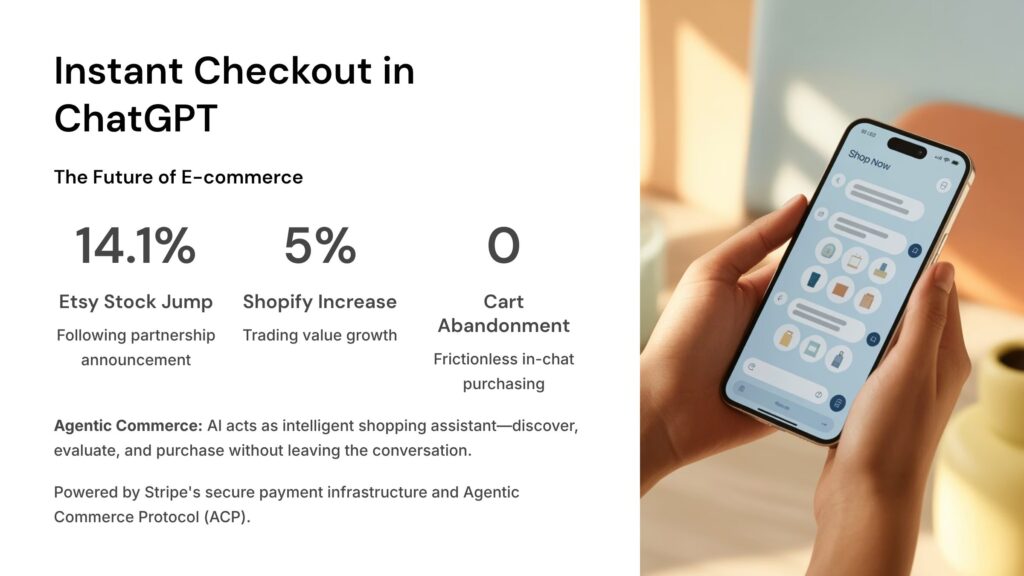
6. Kling AI: Democratizing Professional Video Creation
The content creation landscape is experiencing another seismic shift with the advancement of Kling AI, a sophisticated text-to-video generation platform developed by Kuaishou Technology. This tool represents a significant leap forward in making professional-quality video production accessible to creators regardless of their technical expertise or budget constraints.
Kling AI’s latest iteration, version 2.5 Turbo, has topped industry leaderboards for video generation quality while simultaneously reducing costs by 30% for 1080p video production. The platform’s strength lies in its ability to generate hyper-realistic motion and cinematic camera movements, creating content that rivals traditional film production in terms of visual quality.
The technical architecture employs advanced diffusion models that start with random noise and gradually refine it into coherent video content based on text prompts or input images. The system’s ability to maintain consistency in lighting, physics, and even subtle emotional expressions across video frames represents a significant technological achievement in generative AI.
Recent updates have introduced features like Motion Brush for controlling specific movements within scenes and advanced camera controls for professional-style panning and zooming effects. These capabilities enable creators to produce content that would traditionally require expensive equipment and extensive post-production work.
The implications for various industries are substantial. Marketing teams can rapidly prototype video content, educators can create engaging visual materials, and independent creators can compete with larger production houses. The democratization of high-quality video production could lead to an explosion of visual content across social media platforms and educational resources, fundamentally changing how information is packaged and consumed in the digital age.Source: https://aimindupdate.com/2025/10/05/kling-ai-create-stunning-videos-from-text-beginners-guide/
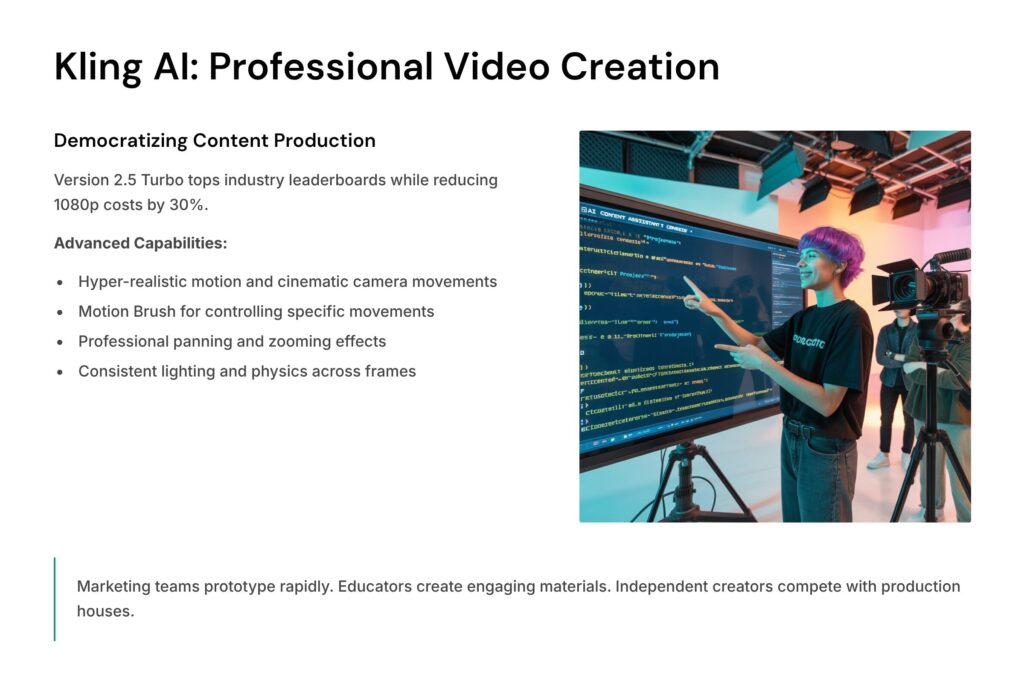
7. Microsoft’s Data API Builder: Simplifying Database Integration
Microsoft has introduced a game-changing tool for developers struggling with database integration complexity: the Data API Builder (DAB). This open-source solution addresses one of the most time-consuming aspects of application development by automatically generating REST and GraphQL APIs from existing database schemas.
The Data API Builder supports a comprehensive range of database systems, including Azure SQL Database, Cosmos DB, MySQL, and PostgreSQL, making it a versatile solution for organizations with diverse data infrastructure. The tool’s declarative approach allows developers to describe what they want to expose rather than coding how to implement it, significantly reducing development time and potential errors.
Recent updates to version 1.6 have introduced flexible logging capabilities to Azure Log Analytics and enhanced HTTP header customization options. These improvements reflect Microsoft’s commitment to making the tool production-ready for enterprise environments where monitoring and compliance are critical requirements.
The configuration process is streamlined through JSON or YAML files where developers define their database entities, set permissions, and specify access controls. Once configured, DAB automatically handles CRUD operations (Create, Read, Update, Delete) and provides OpenAPI specifications for easy integration with other systems.
The strategic implications extend beyond just developer productivity. By lowering the barriers to API creation, Microsoft is potentially accelerating the adoption of its cloud services while enabling organizations to more rapidly expose their data as services. This approach aligns with broader industry trends toward API-first architectures and microservices, positioning Microsoft’s ecosystem as an attractive option for modern application development.Source: https://aimindupdate.com/2025/10/04/unlock-your-azure-data-a-guide-to-microsofts-data-api-builder/
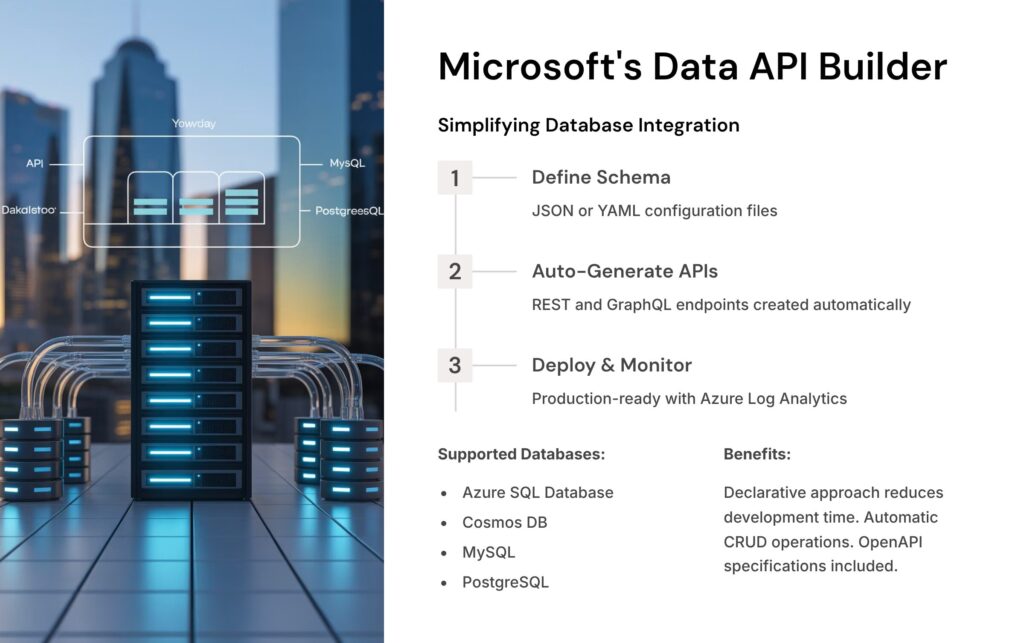
8. Back to Basics: Why AI App Developers Need Old-School Engineering
As the artificial intelligence application development space matures, a counterintuitive trend is emerging: the most successful AI applications are those built on solid, traditional software engineering foundations. This week’s analysis reveals why flashy AI capabilities must be grounded in time-tested development principles to create truly reliable and scalable applications.
The fundamental challenge lies in the unpredictable nature of AI systems compared to traditional deterministic software. While AI models can produce impressive results, they can also exhibit unexpected behaviors, hallucinate information, or degrade performance over time. These characteristics make traditional engineering practices like rigorous testing, modular architecture, and comprehensive monitoring more critical, not less.
Key old-school principles proving essential for AI applications include modularity (building systems as interchangeable components), reliability through extensive testing of edge cases, maintainability for updating models and code, scalability planning from the start, and security-first approaches that don’t rely solely on AI model behavior for protection.
Recent surveys indicate that experienced developers are more successful at integrating AI tools precisely because they apply these traditional quality assurance practices. They understand that AI should augment, not replace, solid engineering fundamentals like version control, documentation, code reviews, and systematic testing procedures.
The implications for the AI development community are significant. As the initial excitement around AI capabilities matures, the industry is recognizing that sustainable AI applications require the same disciplined approach to software engineering that has proven successful in traditional development. This realization is driving demand for developers who can bridge AI innovation with engineering best practices, creating a new category of professionals who combine cutting-edge AI knowledge with foundational software development skills.Source: https://aimindupdate.com/2025/10/04/ai-app-developers-time-to-embrace-old-school-engineering/
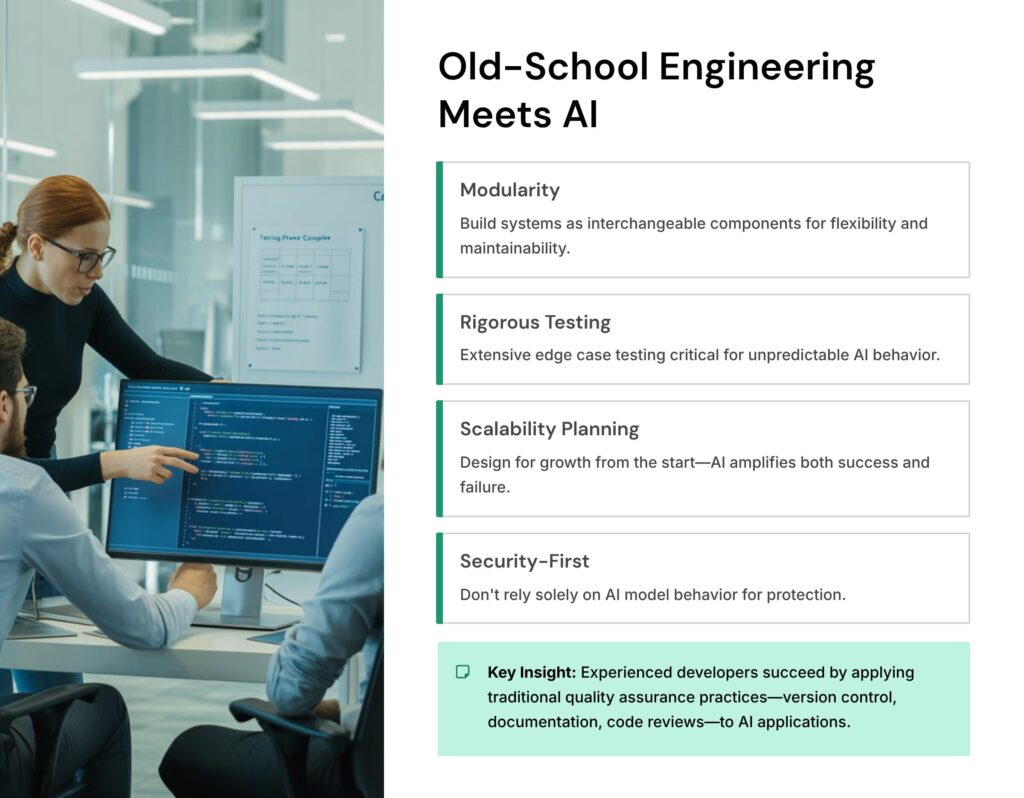
9. Apache Iceberg: Transforming Observability Data Management
The observability landscape is undergoing a fundamental transformation with the integration of Apache Iceberg, an open-source table format that’s revolutionizing how organizations handle telemetry data from logs, metrics, and traces. This development addresses one of the most pressing challenges in modern system monitoring: making massive volumes of observability data queryable, shareable, and actionable at enterprise scale.
Traditional observability approaches often result in data silos where telemetry information is trapped in vendor-specific formats or proprietary systems, making it difficult to perform comprehensive analysis or share insights across teams. Apache Iceberg solves this by providing a standardized, open table format that treats observability data as a first-class enterprise asset.
The technical advantages of Iceberg for observability are substantial. ACID compliance ensures data integrity even when multiple systems are writing telemetry data simultaneously. Schema evolution capabilities allow monitoring systems to adapt their data structures without breaking existing queries. Time travel functionality enables teams to examine system state at specific points in time, which is invaluable for debugging complex distributed systems.
Recent developments show Apache Iceberg version 3 delivering significant performance improvements for data lakehouses, with faster query execution and better handling of massive data volumes. Companies are increasingly adopting Iceberg to store observability data in cost-effective object storage while maintaining the ability to perform sophisticated analytics using standard SQL tools.
The broader implications suggest a shift toward treating observability data as a strategic business asset rather than just operational overhead. Organizations can now perform advanced analytics on their telemetry data, feeding insights into business intelligence systems and even training machine learning models to predict system failures or optimize performance proactively.Source: https://aimindupdate.com/2025/10/04/observability-reimagined-why-apache-iceberg-is-the-future/
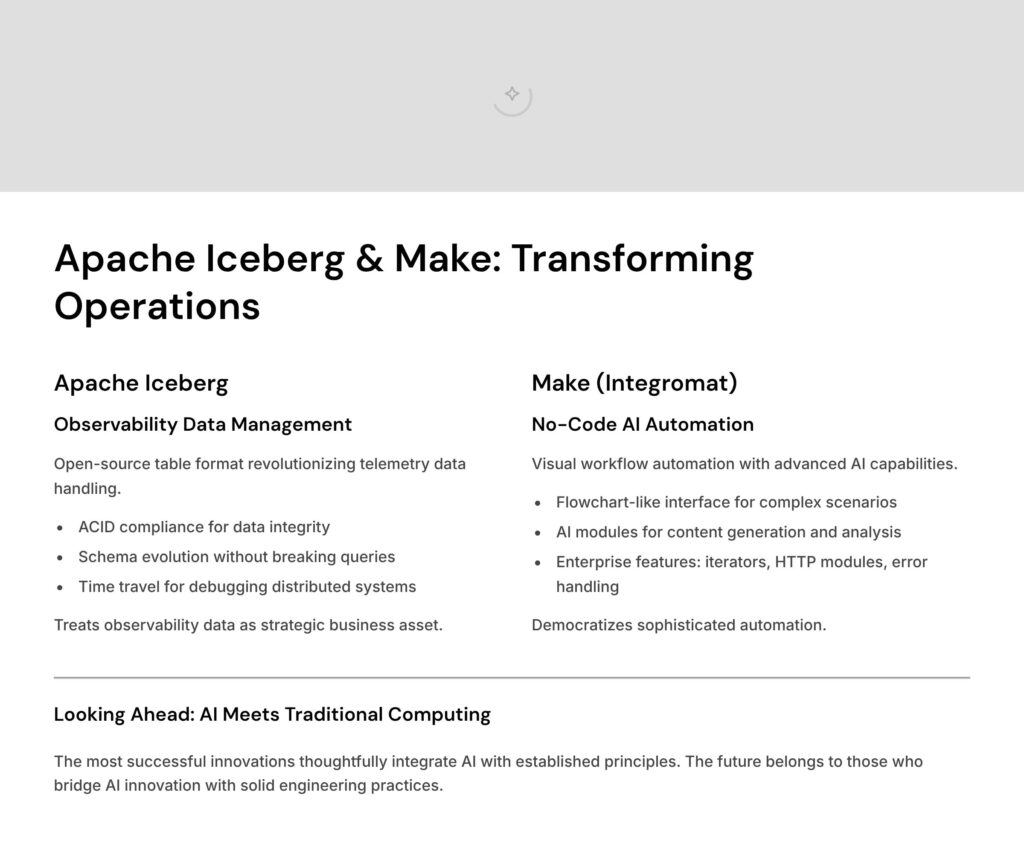
10. Make (Integromat): Pioneering No-Code AI Automation
The no-code automation landscape has evolved significantly with Make (formerly Integromat) emerging as a sophisticated platform that bridges traditional workflow automation with advanced AI capabilities. This evolution represents a crucial development in making complex AI integrations accessible to non-technical users while providing the power and flexibility that technical users demand.
Make’s visual interface allows users to create complex automation scenarios using a flowchart-like approach, where different applications and services can be connected without writing code. The platform’s recent integration of AI modules enables users to incorporate capabilities like content generation, data analysis, and intelligent decision-making into their automated workflows.
The platform’s strength lies in its ability to handle both simple automations, like sending email notifications, and complex multi-step processes that might involve data transformation, API calls, and conditional logic. Recent developments show Make integrating with AI agent frameworks, enabling more sophisticated autonomous workflows that can adapt to changing conditions.
What distinguishes Make from simpler automation tools is its support for advanced features like iterators and aggregators for handling large datasets, HTTP modules for custom integrations, and error handling capabilities that ensure reliable operation in production environments. These features make it suitable for enterprise use cases while remaining accessible to individual users and small businesses.
The implications for business process automation are significant. As AI capabilities become more accessible through no-code platforms, organizations can implement sophisticated automation without requiring extensive technical resources. This democratization of AI automation could accelerate digital transformation initiatives and enable smaller organizations to compete with larger enterprises through intelligent process optimization.Source: https://aimindupdate.com/2025/10/03/make-integromat-decoded-a-2025-guide-to-no-code-ai-automation/
Looking Ahead: The Convergence of AI and Traditional Computing
This week’s developments reveal a fascinating pattern in the evolution of artificial intelligence: the most successful innovations are those that thoughtfully integrate AI capabilities with established computing principles and user needs. From Microsoft’s comprehensive approach to AI agent development to Chainguard’s security-focused JavaScript libraries, we see a maturing industry that values reliability and practicality alongside innovation.
The common thread running through these stories is the democratization of advanced technology. Whether it’s Make’s no-code automation, Kling AI’s accessible video creation, or ChatGPT’s instant checkout functionality, the most impactful developments are those that lower barriers to entry while maintaining professional-grade capabilities.
For technology professionals, these trends suggest that the future belongs to those who can effectively bridge the gap between AI innovation and solid engineering practices. The developers, architects, and business leaders who succeed will be those who understand both the possibilities and limitations of AI, applying these tools strategically rather than as solutions in search of problems.
As we move forward, the integration of AI into everyday business processes will likely accelerate, but success will depend on implementing these technologies thoughtfully, with appropriate security measures, user experience considerations, and fallback mechanisms. The week’s news suggests we’re entering a more mature phase of AI adoption, where the focus shifts from what’s technically possible to what’s practically valuable and reliably sustainable.
Tags: artificial intelligence, software development, JavaScript, internal developer platforms, Microsoft Agent Framework, supply chain security, e-commerce, ChatGPT, video generation, database APIs, observability, Apache Iceberg, no-code automation, AI applications, developer tools, cybersecurity, machine learning, cloud computing, API development, DevOps
